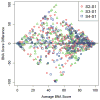Stability of an ERP-based measure of brain network activation (BNA) in athletes: A new electrophysiological assessment tool for concussion
- PMID: 27245767
- PMCID: PMC4988883
- DOI: 10.3109/02699052.2016.1160152
Stability of an ERP-based measure of brain network activation (BNA) in athletes: A new electrophysiological assessment tool for concussion
Abstract
Primary objective: To determine test-re-test reliabilities of novel Evoked Response Potential (ERP)-based Brain Network Activation (BNA) scores in healthy athletes.
Research design: Observational, repeated-measures study.
Methods and design: Forty-two healthy male and female high school and collegiate athletes completed auditory oddball and go/no-go ERP assessments at baseline, 1 week, 6 weeks and 1 year. The BNA algorithm was applied to the ERP data, considering electrode location, frequency band, peak latency and normalized amplitude to generate seven unique BNA scores for each testing session.
Main outcomes and results: Mean BNA scores, intra-class correlation coefficient (ICC) values and reliable change (RC) values were calculated for each of the seven BNA networks. BNA scores ranged from 46.3 ± 34.9 to 69.9 ± 22.8, ICC values ranged from 0.46-0.65 and 95% RC values ranged from 38.3-68.1 across the seven networks.
Conclusions: The wide range of BNA scores observed in this population of healthy athletes suggests that a single BNA score or set of BNA scores from a single after-injury test session may be difficult to interpret in isolation without knowledge of the athlete's own baseline BNA score(s) and/or the results of serial tests performed at additional time points. The stability of each BNA network should be considered when interpreting test-re-test BNA score changes.
Keywords: Athlete; brain network activation; concussion; electroencephalography; event-related potential; reliability.
Conflict of interest statement
Dr. Eckner has received research support from ElMindA, LTD. His active research funding includes the National Institutes of Health (1 K23 HD078502), the National Collegiate Athletics Association, the United States Department of Defense (14132004), the University of Michigan Injury Center, and the Foundation for Physical Medicine and Rehabilitation. Ms. Rettmann has received research support from ElMindA, LTD. Mr. Greer has received research support from ElMindA, LTD. Mr. Moore has received research support from ElMindA, LTD. Ms. Brimacombe has received research support from ElMindA, LTD. Dr. He has received research support from ElMindA, LTD. Dr. Broglio has received research support from ElMindA, LTD. His active research funding includes the National Institutes of Health (1R15NS081691-01, 3R15NS081691-01S1), the National Collegiate Athletic Association, the United States Department of Defense (14132004), and the University of Michigan Injury Center. Mr. Narisetty reports no declarations of interest.
Figures





References
-
- McCrory P, Meeuwisse WH, Aubry M, Cantu B, Dvorak J, Echemendia RJ, Engebretsen L, Johnston K, Kutcher JS, Raftery M, et al. Consensus statement on concussion in sport: the 4th International Conference on Concussion in Sport held in Zurich, November 2012. British Journal of Sports Medicine. 2013;47(5):250–258. - PubMed
-
- Gosselin N, Theriault M, Leclerc S, Montplaisir J, Lassonde M. Neurophysiological anomalies in symptomatic and asymptomatic concussed athletes. Neurosurgery. 2006;58(6):1151–61. discussion 1151–61. - PubMed
-
- Dupuis F, Johnston K, Lavoie M, Lepore F, Lassonde M. Concussions in athletes produce brain dysfunction as revealed by event-related potentials. Neuroreport. 2000;11(18):4087–4092. - PubMed
-
- Baillargeon A, Lassonde M, Leclerc S, Ellemberg D. Neuropsychological and neurophysiological assessment of sport concussion in children, adolescents and adults. Brain Inj. 2012;26(3):211–20. - PubMed
-
- Gosselin N, Saluja RS, Chen JK, Bottari C, Johnston K, Ptito A. Brain functions after sports-related concussion: insights from event-related potentials and functional MRI. Phys Sportsmed. 2010;38(3):27–37. - PubMed
Publication types
MeSH terms
Grants and funding
LinkOut - more resources
Full Text Sources
Other Literature Sources
Medical
